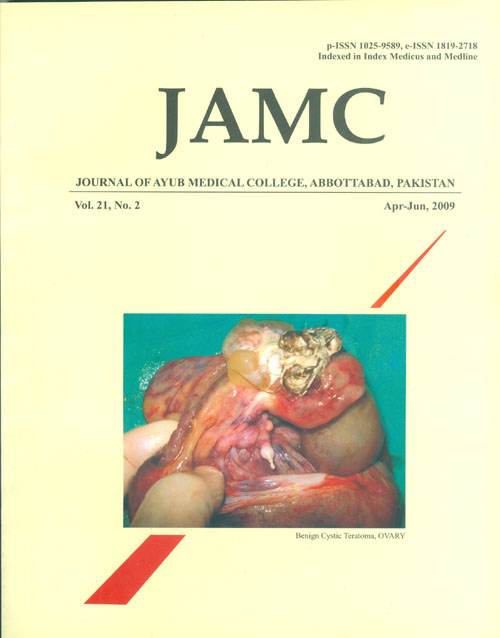INCIDENCE OF ENDOMETRIAL HYPERPLASIA IN 100 CASES PRESENTING WITH POLYMENORRHAGIA/MENORRHAGIA IN PERIMENUPAUSAL WOMEN
Abstract
Background: To study the Incidence of endometrial hyperplasia in perimenupausal women presentingwith polymenorrhagia/menorrhagia. This observational study was conducted at Gynae ‘B’ unit ofKhyber Teaching Hospital Peshawar from January 2000 to December 2001. Methods: One hundredconsecutive patients who presented at Gynaecology OPD with Polymenorrhagia/ Menorrhagia wereregistered and incidence of endometrial hyperplasia evaluated in them. All women were above 45 yearsof age. Post-menopausal bleeding cases were excluded from the study. Results: Out of 100 patients, 15patients were found to have endometrial hyperplasia, 10 patients (66.6%) simple cystic hyperplasia, 3patients (20.0%) had adenomotous hyperplasia, 2 patients (13.3%) had atypical hyperplasia, 8 patients(53.3%) with menorrhagia, 1 (6.6%) with polymenorrhagia, and 6 patients (40.0%) withpolymenorrhoea. Duration of symptoms was from 4 months to 1 year. Thirteen (86.6%) patients weretreated medically, 5 patients (33.33%) needed surgical treatment following medical treatment, 2patients (13.3%) underwent Total Abdominal Hysterectomy (TAH) and Bilateral Salpingooophorectomy (BSO) who were 51–53 years of age with atypical hyperplasia. Conclusion:endometrial hyperplasia is a pre-malignant condition; if treated in time, incidence can be reduced andearly treatment can increase life expectancy and quality in women over age of 45 years.Keyword: Menorrhagia, Polymenorrhagia, Endometrial hyperplasia, Transvaginal Ultrasound, TVSReferences
Kurman RJ, Kamiriski PF, Norris HJ. The behavior of
endometrial hyperplasia; A long term study of untreated
endometrial hyperplasia in 170 patients. Cancer
;56:403–12.
Wentz WB. Progestin therapy in endometrial hyperplasia.
Gynaecol Oncol 1974;2:362–7.
Mishal DR, Droegmuller-W, Merbot-AL. Abdominal uterine
bleeding. Corhensive Gynaecology. 953–64.
Niwa K, Morishita S, Hashimoto M, Itoh T, Fujimoto J, Mori
H, et al. Effects of tamoxifen on endometrial carcinogenesis
in mice. Jpn J Cancer Res 1998;89(5):502–9.
Fox H, Langley FA. eds. Tumours of ovary. London:
Heinemann Medical;1976. p.119–37.
Tavasolli F, Krawz FT. Endometrial lesions in uteri resected
for atypical endometrial hyperplasia. Am J Clin Pathol
;70:770–9.
Colgan TJ, Norris HJ, Foster W, Kurman RJ, Fox CH..
Predicting the outcome of endometrial hyperplasia by
quantitive analysis of nuclear features using a linear
discriminate function. Int J Gynaecol Pathol 1983;1(4):347–52.
Campbell PE, Barter RA. The significance of atypical
hyperplasia. J Obstet Gynaecol Br Commonw 1961;68:668–72.
Sommers SC. The clinical significance of endometrial
hyperplasia and its early diagnosis. In Barber HRK, Graber
EA (eds): Gynecologic Oncology. Baltimore: Williams &
Wilkins; 1970.
Horbelt DV, Roberts DK, Parmley TH, Walker NJ.
Ultrastructure of the microvasculature in human endometrial
hyperplasia. Am J Obstet Gynecol 1996;174(1 Pt-1):174–83.
Mughal N. Diagnostic Value of endometrial curettage, in
abnormal uterine bleeding. J Pak Med Assoc
;47(12):295–8.
Fayyaz S, Majeed SS. Audit of Gynaecological
hysterectomies. J Postgrad Med Inst 2001;15(2):208–12.
Riffat Jalil. A study to correlate the indication of abdominal
hysterectomy with histopathological findings. 1998. (FCPS
Dissertation).
Adil F. D&C in excessive and abnormal uterine bleeding (2
year study) Obst Gynae B Unit Dow Medical College
Karachi. 1997 (FCPS Dissertation)
Terakawa N, Kigawa J, Taketani Y, Yoshikawa H, Yajima
A, Noda K, et al. The behavior of endometrial hyperplasia: a
prospective study. Endometrial Hyperplasia Study Group. J
Obstet Gynaecol Res 1997;23(3):223–30.
Menwissen JH et al 1996, Endometrial Biopsy the female
patient 1993,4:19–23.
Bakos O, Heimer G. Transvaginal Ultrasonography
evaluation of the endometirum related to the histological
findings in pre-and permenopausal women. Gynaecol Obstet
Invest 1998;45(3):199–204.
el-Ahmady O, Gad M, el-Sheimy R, Halim AB, Eissa
S, Hassan F, et al. Comparitive study between sonography
pathology and UGP in women with periomenopausal
bleeding. Anticancer Res 1996;16(4B):2309–13.
Ben Yehuda OM, Kim YB, Leuchter RS. Does Hysteroscopy
improve upon the sensitivity of dilatation and curettage in the
diagnosis of endometrial hyperplasia or carcinoma?
Gynaecol Oncol1998;68(1):4–7.
Ho SP, Tan KT, Pang MW, Ho TH. Endometrial hyperplasia
and the risk of endometrial carcinoma. Singapore Med J
;38(1):11–5.
Gücer F, Reich O, Tamussino K, Bader AA, Pieber D, Schöll
W, et al. Concomitant endometrial Hyperplasia in patients with
endometrial carcinoma. Gynaecol Oncol 1998;69(1)64–8.
Colacurci N, De Placido G, Mollo A, Perino A, Cittadini E.
Short term use of Goserlin Depot in the treatment of
dysfunctional uterine bleeding. Clin Exp Obstet
Gynecol 1995;22:212–9.
Gimpalson RJ. Not so benign endometrial hyperplasia:
endometrial cancer after endometrial ablation. J Am Assoc
Gynaecol Laprarosc 1997;4(4):507–11.
Published
Issue
Section
License
Journal of Ayub Medical College, Abbottabad is an OPEN ACCESS JOURNAL which means that all content is FREELY available without charge to all users whether registered with the journal or not. The work published by J Ayub Med Coll Abbottabad is licensed and distributed under the creative commons License CC BY ND Attribution-NoDerivs. Material printed in this journal is OPEN to access, and are FREE for use in academic and research work with proper citation. J Ayub Med Coll Abbottabad accepts only original material for publication with the understanding that except for abstracts, no part of the data has been published or will be submitted for publication elsewhere before appearing in J Ayub Med Coll Abbottabad. The Editorial Board of J Ayub Med Coll Abbottabad makes every effort to ensure the accuracy and authenticity of material printed in J Ayub Med Coll Abbottabad. However, conclusions and statements expressed are views of the authors and do not reflect the opinion/policy of J Ayub Med Coll Abbottabad or the Editorial Board.
USERS are allowed to read, download, copy, distribute, print, search, or link to the full texts of the articles, or use them for any other lawful purpose, without asking prior permission from the publisher or the author. This is in accordance with the BOAI definition of open access.
AUTHORS retain the rights of free downloading/unlimited e-print of full text and sharing/disseminating the article without any restriction, by any means including twitter, scholarly collaboration networks such as ResearchGate, Academia.eu, and social media sites such as Twitter, LinkedIn, Google Scholar and any other professional or academic networking site.









